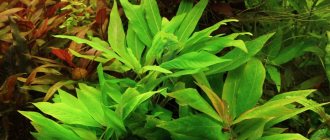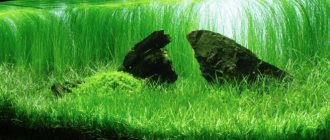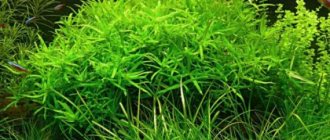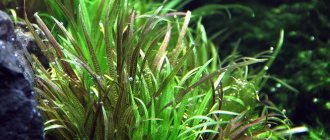Java moss is one of the easiest to grow and hardiest aquarium plants. It belongs to the Hypnaceae family and is native to Southeast Asia. Moss is common in humid tropical climates and grows on rocks, river banks and tree trunks. Due to the low requirements for water quality and lighting, this is perhaps the most common moss among beginner aquarists. The plant also acts as a protection for eggs and fry, a natural filter and fish food.
Why you should get moss
Java moss reduces algae. Their growth in an aquarium can have a negative impact on the overall appearance of the tank and interfere with the normal functioning of the fish. The plant absorbs nutrients that primitive organisms need and also helps in the process of oxygenation. The carbon dioxide released by the fish during respiration is used by the plant during photosynthesis. There are many alternative methods to ensure proper aeration, but the use of moss is considered more effective.
Restores Natural Habitat: By planting Java moss in your aquarium, fish will live in an environment similar to their natural ecosystem, which can have a positive effect on their growth and spawning.
Provides a substrate in the aquarium and adds an artistic look. Aquatic plants such as moss have extended root systems that can protect the substrate in your aquarium.
Appointment in the aquarium
Java moss is also loved by aquarists for its versatility. It not only performs a decorative function, but also has a number of useful qualities.
The thickets are a safe place for spawning fish, which lay their eggs on their leaves. For this reason, Java moss is very often used in spawning tanks. Even in a general-species aquarium, in the case of spontaneous spawning, some of the eggs are preserved, since the “parents” and other inhabitants cannot get close to them and eat them. If necessary, the bushes chosen by the egg-laying fish for spawning are transferred from the general tank to the hatchery, where the eggs develop in safety. The thickets are used as spawning habitat by barbs, characin fish species, and representatives of the killfish family.
The benefits of moss are also obvious for juveniles. Due to the abundance of ciliates in the thickets, it is the main reservoir of food for young fish and shrimp.
The decorative function is not inferior in importance and provides great opportunities for expressing design ideas. Java moss was one of the first to be used to create aquascaping.
Description and varieties
The plant is an interweaving of thin threads of dark green color, tightly attached to the irregularities of stones and snags. Moss, which is not disturbed for a long time, forms very beautiful thickets. It can be used as a spawning substrate for many fish species. Java moss grows slowly but evenly throughout the year.
| Java moss | The most common and famous aquarium moss. He gained popularity due to his attractive appearance, endurance and unpretentiousness. |
| Fissidens fontanus | In the wild, phoenix moss grows in North American waters. It has the shape of a mound or fountain (the latter gave it its Latin name). Due to its high growth rate, it can be recommended even to beginners. Phoenix moss is also used as a ground cover plant: its shoots hang quite beautifully on driftwood and stones, and resemble a green fountain. This moss is undemanding and grows in the temperature range from 15 to 28°C, however, when it reaches extreme values, the growth rate decreases significantly. The plant prefers soft water. |
| Flame Moss (Taxiphyllum sp. "Flame") | The plant gets its name from its appearance, which resembles bursts of flame. Unlike other types of mosses, it grows upward much faster than in width. Comfortable water parameters in the tank for Flame moss are as follows: water temperature 20-28° C, dH from 4 to 9°, acidity pH from 6 to 7.5. The method of rolling the moss leaves depends on the hardness of the water. |
| Pellia Moss (Monosolenium tenerum) | The leafless Pellia moss is very similar to the Riccia plant. It is heavier than water, and therefore always remains at the bottom of the aquarium, does not require storage, and as soon as it begins to grow, it spreads throughout the aquarium, forming quite beautiful green “cushions” at the bottom of the tank. The plant feels great in a fairly wide temperature range (from 5 to 30 C). Moss can grow in both shade and bright light, in hard and soft water. Under less favorable conditions, it grows more slowly (up to 3 cm), has a narrow shape (up to 5 mm) and looks less decorative. At the bottom of the moss structure there are rhizoids, with the help of which the moss sticks to stones or snags. |
| Weeping Moss (Vesicularia Ferriei) | It grows up to 3 cm in height, the width of the moss bush is 5 cm. Comfortable water parameters are as follows: water temperature from 22 to 28 ° C, pH from 5.5 to 8, KH from 6 to 14 °. Weeping moss can withstand even higher temperatures (up to 32°C) without losing its appearance, although its branches may turn yellow. The supply of CO2 stimulates its growth and improves the appearance of moss |
Appearance of Java moss
Thin long stems with small leaves of different shades of green create an underwater jungle that attracts the eye. Height reaches 17 cm, leaves up to 2 mm. The color depends on the age: the younger the plant, the brighter it is. External factors also affect color. As they worsen, the leaves may darken and even turn brown. Externally, moss looks like an interweaving of branching stems that develop in different ways.
At first glance it may seem that it is firmly rooted to the ground. In fact, these rhizoid threads “stick” to any hard surface.
With the help of Javanese, as with other types of mosses, you can create amazing compositions, making the appearance of the aquarium unique.
Conditions of detention
Java moss is a hardy plant that thrives in any water. The size of the tank must be at least 5 liters per 10 centimeters of plant. It prefers to live in an aquarium with moderate lighting and does not require a special substrate for planting.
The ideal water temperature for growth is 15-30°C. Change 20% of the water weekly. Try to keep the temperature, pH level and hardness of the new batch of water the same.
Avoid using soaps with chemicals. To clean the aquarium, use warm water and mild liquid soap. Use a siphon to clean gravel, decorations and aquarium rocks.
We take proper care
You can let the moss grow wild, trimming it only occasionally when necessary, or fashion it into specific shapes. Apart from pruning, the plant has no other special maintenance requirements. It can be used to coat filters - this should be done with caution as it will clog them.
Moss on the bottom of the tank tends to collect debris that may not be noticeable to humans but is toxic to the plant. This happens when a large amount of it accumulates. To clean moss, remove it from the aquarium and rinse thoroughly under running water.
Scope of application
Java moss is an unpretentious aquarium plant that does not require special care. With its help, you can realize the most original ideas for aquarium design without significant costs and saving the family budget. These features make the plant popular among aquarists.
The popularity of the culture is due to a large number of advantages:
- beautiful appearance;
- unpretentiousness in care and maintenance;
- ability to attach to any surface;
- growing in containers of various sizes;
- positive effect on the microflora of an artificial reservoir.
Therefore, this unusual plant can perform the following functions:
- Decorating the aquarium. Moss has the ability to add a natural, earthy feel to whatever it grows on. It can quickly and easily breathe life into any dull aquarium design.
- Spawning site for aquarium fish. Moss provides a safe shelter for eggs and larvae; large fish find it difficult to find them in such a substrate.
- Additional food. The plant can be the basis for the reproduction of ciliates, which are a vital source of food for fry. In this case, it is recommended to leave the moss in the form of a free-floating lump, without attaching it to the decor.
How to start a plant
Reproduction occurs by dividing its colony into parts. There are several ways to plant moss:
- Place some java moss on the surface of the water if you want it to float freely.
- Wrap fishing line or dark thread around a thin layer of the plant and tie it into a small knot. It will help the roots grow in the direction of the decorative element.
- To attach the moss, you must lay a thin layer of it on the rock or driftwood you want to attach it to, and secure the plant with fishing line or dark thread. Once it grows in naturally, the thread can be removed after a month or so.
The above-water form of Java moss is more decorative than the aquatic one. It is advisable to periodically dry the plant to combat algae that has formed on its leaves.
Habitat
This epiphyte is native to Southeast Asia and the island of Java. Perhaps this explains his unpretentiousness. It is also found naturally in Japan, Indonesia, Singapore, Vietnam, the Philippines and Malaysia.
The name was obtained due to the fact that moss was brought to Europe from the island of Java in the last century.
It grows in humid tropical regions on rocks, along the banks of rivers, lakes and swamps, entwines tree trunks or floats in the water column. Like all mosses, it accumulates moisture and retains it during dry periods.
Why isn't it growing?
A common problem faced by Java moss breeders is algae growth. Once they begin to grow, they are almost impossible to remove and the entire plant should be discarded.
The best way to prevent the growth of microorganisms is to avoid excessive light and keep the water clean. Increased concentrations of nitrates and phosphates also promote algae growth.
The plant easily gets along with other aquatic species. Catfish and shrimp act as moss caretakers (they absorb the remains of organic matter that settle in the leaves).
Compatibility with fish
An aquarium sparsely populated with small fish species is perfect for Java moss.
It is vulnerable to attacks from some aquatic inhabitants, but gets along well with neons, angelfish and shrimp. Neocaridina and caridina shrimp, which continuously move along the branches of moss, eating remaining food and deposited debris from its leaves, help maintain the decorative appearance of the Javanese.
Fertilizers
You can add liquid fertilizer (like LeafZone) and adjust the CO2 dosage to speed up moss growth. Root feeding is pointless, since the plant does not take root.
Java moss allows you to create improvised trees: for this you use a piece of driftwood standing vertically.
The plant is suitable for almost all aquariums. It has a wide range of uses - from adding aesthetic beauty to an aquarium to providing shelter for newborn fry. It is also extremely easy to grow, making it ideal for both beginner aquarists and professionals.
Reproduction
The many positive qualities of Java moss have made it a popular plant among aquarists. You can purchase the plant in many stores. If it already decorates the tank and has become too large for it, then it is simply divided and multiplied in this way.
Growing moss is quite simple. Any cut piece grows, regardless of size.
Resourceful aquarists even crushed the plant in a mixer and placed the resulting pulp on rocks and roots.
It is not recommended for amateurs to conduct such experiments, as other substances are mixed in. Nevertheless, the result is noteworthy.
For reliability, only healthy, fairly tall specimens should be used. The mother plant is divided or a strong daughter plant is separated from it. It is important that the seedlings have enough intact rhizoids for attachment. “New” plant parts must be immediately planted in the aquarium.











